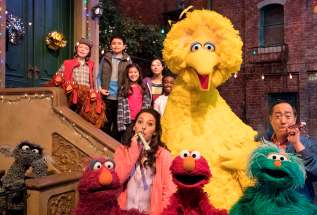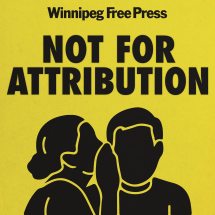Street cred A look back on the impact of the groundbreaking children's TV show as it celebrates 50 years
Read this article for free:
or
Already have an account? Log in here »
To continue reading, please subscribe:
Monthly Digital Subscription
$0 for the first 4 weeks*
- Enjoy unlimited reading on winnipegfreepress.com
- Read the E-Edition, our digital replica newspaper
- Access News Break, our award-winning app
- Play interactive puzzles
*No charge for 4 weeks then price increases to the regular rate of $19.00 plus GST every four weeks. Offer available to new and qualified returning subscribers only. Cancel any time.
Monthly Digital Subscription
$4.75/week*
- Enjoy unlimited reading on winnipegfreepress.com
- Read the E-Edition, our digital replica newspaper
- Access News Break, our award-winning app
- Play interactive puzzles
*Billed as $19 plus GST every four weeks. Cancel any time.
To continue reading, please subscribe:
Add Free Press access to your Brandon Sun subscription for only an additional
$1 for the first 4 weeks*
*Your next subscription payment will increase by $1.00 and you will be charged $16.99 plus GST for four weeks. After four weeks, your payment will increase to $23.99 plus GST every four weeks.
Read unlimited articles for free today:
or
Already have an account? Log in here »
Hey there, time traveller!
This article was published 03/09/2019 (2291 days ago), so information in it may no longer be current.
Fifty years ago this fall, a show that would revolutionize children’s television debuted on America’s Public Broadcasting Service. A critical hit from the start, Sesame Street was — is — unlike anything else on TV.
Sesame Street didn’t just teach multiple generations of children their ABCs and 123s. It also taught them valuable lessons about what it means to be a person in the world. Aided by a colourful, now-iconic cast of characters, the show educated without condescending to its young viewers, and wasn’t afraid of tackling tough subjects.
TAKE FIVE
In a regular series, the Free Press explores five great things. Send us your feedback at arts@freepress.mb.ca.
Now, 49 seasons and 189 Emmy Awards later, Sesame Street is still going strong. To celebrate that milestone, here are five times Sesame Street was super progressive.
Buffy Sainte-Marie breastfeeds her son (1977)
The Canadian-American singer/songwriter was a recurring cast member on the show from 1975 to 1981, teaching children about Indigenous culture. In 1977, she became the first woman to breastfeed on national television.
In the short clip, Buffy feeds her son, Dakota “Cody” Starblanket Wolfchild, while a curious Big Bird asks her questions about what she’s doing and why.
“Lots of mothers feed their babies this way,” she explains to him. “Not all mothers, but lots of mothers do.”
Not only is it completely free of mom-shaming, this scene simply and effectively explains and normalizes breastfeeding to a young audience — although there are certainly adults out there who could benefit from a remedial viewing, too.
Saying goodbye to Mr. Hooper (1983)
How do you talk to a child about death? Sesame Street figured out how to thread this particularly tricky needle in this Peabody- and Emmy-winning episode in which Big Bird must grapple with the death of his friend, Mr. Hooper.
When Will Lee, the actor who played the kindly shopkeeper died in real life, the show decided to deal with his death head on, working with child psychologists and development experts. In a landmark scene, Big Bird is passing out the hand-drawn pictures he’s made of all his grown-up friends, and asks them where Mr. Hooper is. The adults compassionately explain to Big Bird that Mr. Hooper has died and, because he is dead, he is never coming back, and he will be missed very much.
Most strikingly, the adults in the scene do not rely on euphemisms; they never say Mr. Hooper “went to sleep” or “passed away.” Big Bird, meanwhile, goes through the stages of grief. “I don’t like it, it makes me sad,” he says, choking up, before getting angry. The adults comfort Big Bird by addressing fears a child might have, such as who will tell him stories, who will make his birdseed milkshakes and who will take care of him.
It is one of the most iconic scenes in the show’s run, and is regarded as the benchmark for dealing with mortality for a young audience. (It’s also almost impossible to watch without fully bawling so, you know, buckle up.)
The reveal of Snuffy (1985)
Aloysius Snuffleupagus — or Mr. Snuffleupagus, or Snuffy — was, for a long time, thought to be the imaginary friend of Big Bird. The bashful, long-lashed, wooly-mammoth-esque creature never seemed to be around when other people were in the scene, always leaving before Big Bird could return with other friends. And like an imaginary friend, Snuffy often became a scapegoat for Big Bird.
But in the early 1980s, following a 60 Minutes series on child abuse, the show’s writers and producers decided that having a running gag in which adults disbelieve Big Bird may potentially send a dangerous message to kids — especially since young viewers can also see Snuffy.
And so, in the Season 17 première in 1985, Snuffy is finally revealed to the adults. Susan (Loretta Long) apologizes to Big Bird for not believing him, while Bob (Bob McGrath) tells him, “From now on, we’ll believe you whenever you tell us something.”
Racism on Sesame Street (1993)
In a 1993 episode, Gina (Alison Bartlett-O’Reilly) and her best friend Savion (Savion Glover) return to Sesame Street after seeing a movie. They play a quick round of basketball and transform a discarded mattress into a trampoline before Gina starts work at Hooper’s. There, she receives a call that clearly upsets and disturbs her. The viewer never hears what’s on the other line when Gina and Savion confront the caller, but Telly — the chronically worried fuschia monster — asks what happened. Savion explains there are “just some really stupid people in the world, who can’t stand to see it when people of different races are friends.”
“Because Sav’s skin is brown and mine is white, he thinks we shouldn’t be friends. It drove him nuts just to see us having fun together,” Gina says.
“What does colour got to do with being friends?” asks Telly.
“Nothing,” Gina says. “Nothing at all.”
As Gina points out in the scene, their block, Sesame Street, is full of diverse people, which is by design. When the show began, it was meant to be a positive depiction of an inner-city New York street, featuring kids and adults of all backgrounds — as well as monsters and grouches and giant birds — living and playing together on the same block. But not even Sesame Street is impervious to racism, and the show’s writers address it in an age-appropriate way.
Meet Karli (2019)
Sesame Street’s progressive moments don’t just exist in its past. This year, Sesame Workshop, the non-profit educational organization behind Sesame Street, unveiled an initiative for children and parents navigating the foster system. One resource is a series of videos featuring Karli, a Sesame Street muppet who lives with her “for now” parents, Daria and Clem.
In one video, she worries that she doesn’t have a place at the table in her new home during a pizza party with Elmo. Elmo asks Daria and Clem what “for-now” parents means, and Daria tenderly explains that sometimes parents need help taking care of their children.
Karli is just the latest in a long line of muppets representing oft-overlooked populations of kids. In the 2000s, Kami, an HIV-positive muppet, appeared on Takalani Sesame Street in South Africa and Sesame Square in Nigeria. In 2016, Zari, a hijab-clad muppet debuted on Baghch-e Simsim, Afghanistan’s version of Sesame Street, to empower girls. And Julia, a muppet with autism, joined the Sesame Street cast in 2017.
jen.zoratti@freepress.mb.ca
Twitter: @JenZoratti

Jen Zoratti is a Winnipeg Free Press columnist and author of the newsletter, NEXT, a weekly look towards a post-pandemic future.
Our newsroom depends on a growing audience of readers to power our journalism. If you are not a paid reader, please consider becoming a subscriber.
Our newsroom depends on its audience of readers to power our journalism. Thank you for your support.



1.jpg?h=215)






